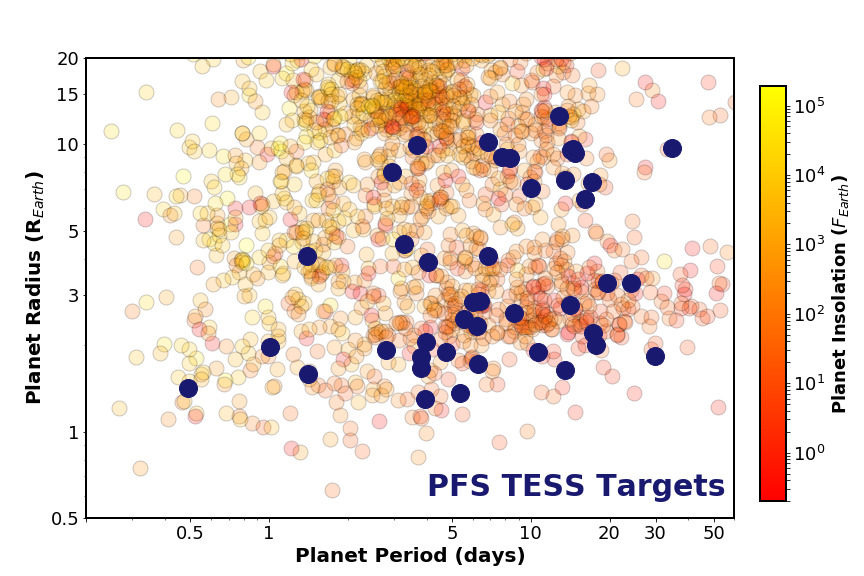Carnegie’s Exoplanet Powerhouse
Carnegie In The News
"Hemingway and his colleagues think they know how the moon got its stripes—and, curiously, why the stripes are found only at the Enceladian south pole."

Since 1999, with Paul Butler’s arrival, Carnegie has been finding and analyzing planets around stars in our galaxy called exoplanets. Carnegie has become world renowned in this research through pioneering detection studies, formation modeling, and more.
Now the Carnegie team, including former Carnegie postdoctoral fellow and now staff scientist Johanna Teske, Butler, Steve Shectman, Jeff Crane, Sharon Wang, and Fabo Feng, provides key support to NASA’s Transiting Exoplanets Survey Satellite (TESS) mission. TESS is searching for exoplanets around stars close to the Sun using the transit method, which looks for starlight dips when a planet crosses in front. Repetitive dips reveal an orbiting planet orplanets. The level of the light dip can determine planet size, and the orbital time can determine the orbit’s shape.

Satellite image - NASA’s Transiting Exoplanets Survey Satellite (TESS), launched in 2018, is surveying 200,000 of the brightest stars near the Sun to search for exoplanets.
TESS, however, needs ground-based telescopes to confirm exoplanets are true exoplanets and to measure their masses. With the planet size, orbit, and mass, astronomers can determine the planets’ compositions—rocky, gassy, or something different.
The Carnegie team uses the Planet Finder Spectrograph (PFS) on the Magellan Clay telescope at Carnegie’s Las Campanas Observatory in Chile to confirm the TESS signal and measure planetary masses. Built by Shectman and Crane, PFS uses a method pioneered by Butler and collaborators called the radial velocity method. It is the only way to measure masses of individual planets, which can help determine planet density or chemical composition This method measures the star’s wobble from a planet’s gravitational influence.
hires.jpg)
Two people -Johanna Teske (left), former Carnegie postdoctoral fellow and the newest staff scientist on the exoplanet team, works with Carnegie’s Jeff Crane (right) on the Planet Finder Spectrograph on the Magellan Clay telescope at Carnegie’s Las Campanas Observatory in Chile.
The instrument is used to confirm and further define exoplanets identified by NASA’s Transiting Exoplanets Survey Satellite (TESS).
In 2019 and 2020, PFS members characterized a slew of TESS’s very different exoplanets. Among them were the first Earth-sized planet (HD 21749c) with an orbit of eight days—the longest-period planet TESS detected—and a companion, a warm sub-Neptune-sized world (HD 21749b).
In 2020, team members reported on two hot planets slightly larger than Earth (GJ 357b and L168-9b) around nearby cool M dwarf stars, a sub-Neptune-sized planet with a Jupiter-analog companion (HD 86226c and b), and an exciting four-planet system (HD 108236b , c, d , e) with all relatively small planets.
There are few precision radial velocity instruments in the Southern Hemisphere, and the PFS is the only such instrument on a large telescope directly accessible to U.S. astronomers. This ensures that the Carnegie team will stay busy with TESS discoveries well into the TESS Extended Mission, and beyond.

When exoplanets were first discovered in the mid-1990s, astronomers had no idea how varied they would be in size, orbital period, distance from their host star, and their angles of inclination to their star. So far, it turns out that there are many systems very different from our own Solar System. This plot (above) shows a sampling of planets discovered by NASA’s Transiting Exoplanets Survey Satellite (TESS). Those in blue are being observed by Carnegie’s Planet Finder Spectrograph team to measure their masses. The rest of the points (non-blue) are other TESS planets that the Carnegie team is not characterizing (at least not yet). TESS measures the radius, at left, and orbital period, bottom. Yellow planets are the hottest. The scale on the right shows how much heat they get from the star.
